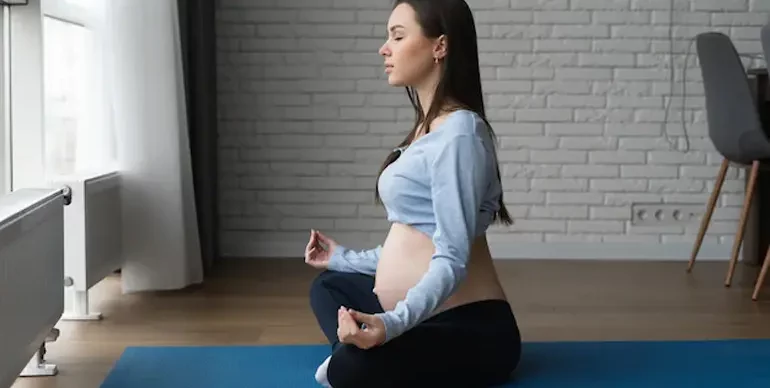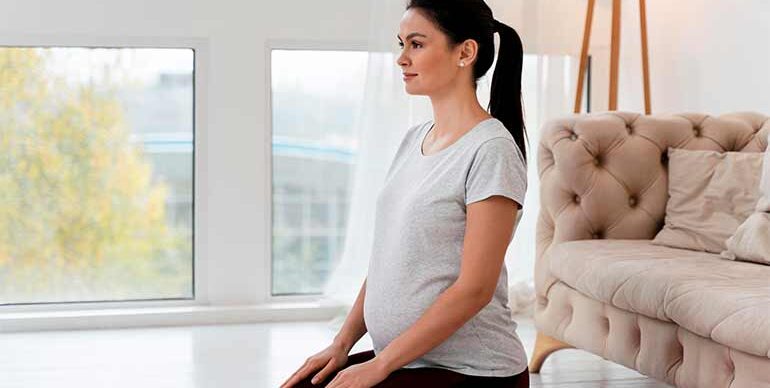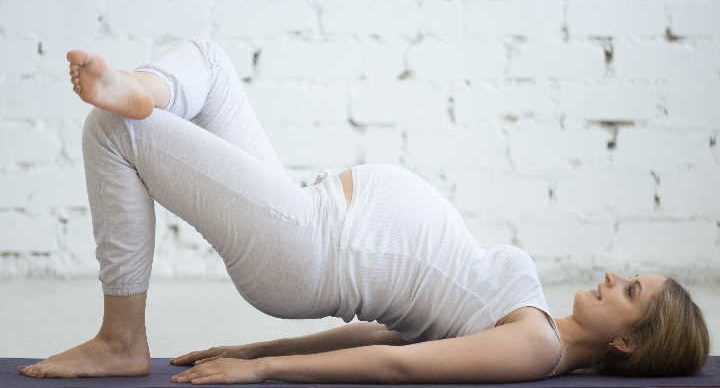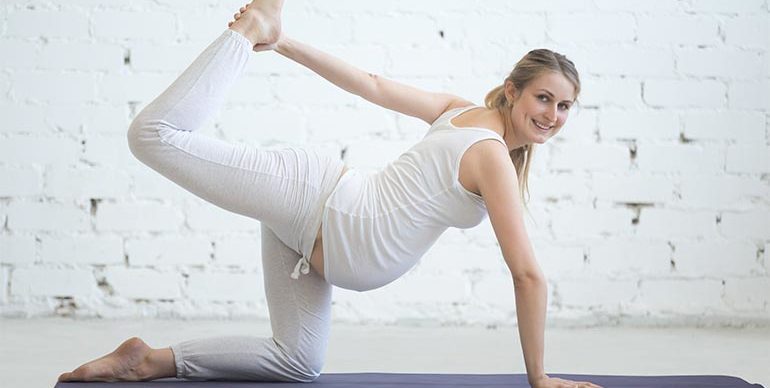
Whether you want to try doing yoga during pregnancy as a first timer in order to make your pregnancy smoother or if you are an regular yoga practitioner who is trying to adapt your yoga routine for the months of pregnancy, the pre natal yoga teachers at Wellintra can help guide you and help you nurture you not only during pregnancy but also in the months following the delivery of your child.
Advice from a Prenatal Yoga Instructor
All our prenatal yoga teachers are selected after a rigorous background check where we not only verify their credentials and experience but also ensure that they are certified from reputable yoga and child care institutes. Our prenatal yoga trainers will help you with information on what to expect both physically and mentally during every pregnancy trimester as also the time onwards when your child is born. Every pregnancy yoga trainer must know how to adapt a woman’s practise to suit each trimester. The maternity yoga trainer must also be aware of the basic dietary and nutrition requirements at every stage during pregnancy and also must know what props are safe to use for a pregnant mother.
Yoga is a powerful practice for women in general and most women can continue to practise yoga after childbirth in order to help get their body back into shape. Yoga can also help a new mother to cope with the emotional upheavals that accompany motherhood. We also know many second or third time mothers who introduce their children to yoga!
The 3 Stages of Pregnancy
Every pregnancy can be divided into three distinct trimesters. Each trimester lasts for three months approximately during which time the mother’s body adapts to support the growing foetus and internally adjusts and primes for the birth. Every woman who desires to go for pre natal yoga must understand all the three stages because each stage involves unique factors for both mother and baby. These development factors must be taken into account when a woman practise prenatal yoga. The labour itself and the postnatal period also have their own separate requirements. Let us review each trimester.
The First Trimester
The First Trimester begins during the time of conception and continues with the development of the embryo which becomes a foetus in the second month. Usually by the end of the first trimester, the foetus begins to show teeth, can swallow, has fully developed hands and the gender is also established. A healthy baby weighs measures approx 3 – 4 inches in length and weighs about 28 gms by the end of the first trimester.
The physical symptoms that an expectant mother can hope to experience during this period range from tender breasts, nausea and vomiting, abdomen tightness and strong energy imbalances as a lot of internal energy is being spent to create a new life. Emotionally speaking, the first trimester can be a volatile period because of the intensity of the transition and an increase in hormone levels.
This period can also be one where the risk of miscarriage is highest as the placenta is not yet fully formed to support the baby and the hormones are unstable. So gentle movements, conservation of energy and the highest level of safety should be the keywords for a pregnant woman in this period. The yoga postures that a pregnant woman can do in the first trimester are:
Yoga For the First Trimester
- Child’s Pose, Legs up against the wall & Corpse Pose in order to maintain energy levels. Go slow and rest when you have to.
- Breathing exercises starting with Full Yogic breathing.
- Develop awareness of the pelvic joints through asanas such as Hip Rolls, Bridge pose, Cat and Cowface.
- Arm and Leg Extensions and Gentle Lunges in order to stimulate blood circulation to the Pelvis and lower extremities and also open up the hip.
- Mountain Pose which can help you to focus on physical alignment in order to create a great foundation for the body amidst all the changes taking place.
The Second Trimester
The Second Trimester starts from the beginning of the fourth to the start of the seventh month of pregnancy. The placenta by this time is fully functional and hormone levels of a woman begins to stabilise. The size of the uterus grows as the foetus grows and the baby bump begins to show. Because of this, there could be pressure on the belly due to the expanding muscles and ligaments of the pelvis. Blood supply increases to accommodate for the growing baby and hormones like ‘relaxin’ which helps in loosening the ligaments are in greater supply. Mothers can expect to experience swollen gums, changes in blood circulation and body heat as well as lack of stability in the joints. Mothers may also notice that their skin complexion is changing along with changes in their hair quality due to hormonal shifts apart from experiencing heartburn, constipation and nasal blockage. The most important advice is: These symptoms are only temporary!
As the baby grows, it needs more energy and so you will need to eat for two as your appetite increases. It is very important to pay a lot of focus on your diet and nutrition. Throughout the second trimester, the baby’s finger and toe prints will form and the eyes will open. By the fifth month, you will also be able to hear your baby’s voice. So this is a good time to talk, sing and play music to your bump in order to increase the sense of bonding and connection. By the sixth month, your baby will be moving around a lot more and may even be sucking it’s thumb, yawning and stretching! By this time, the baby will also be able to distinguish between light and darkness and teeth and bones will be denser and stronger. By the end of the second trimester, your energy levels will have returned. The following Yoga Poses can be done now:
Yoga For the Second Trimester
- Several rounds of the Surya Namaskar or Sun Salutation will help you develop strength and stamina.
- Warrior Pose will help you develop upper and lower body strength. Wide leg squats, Gentle Plank and Easy Push ups can also be done.
- Hip opening poses such as the Bridge and Hip Rolls will help you to open and support your pelvic muscles.
- Deeper Relaxation and meditation practises will help calm you down and also increase the mother-baby connection.
Precautions for the Second Trimester
Remember if you are beginner then it is absolutely imperative that you do yoga privately with a trained prenatal yoga instructor. Anyhow it pays to heed the following points when doing yoga in the second trimester. Keep a gentle flow going in and out of every asana. Try not to jolt, jump or jerk your body or stress it in any way. Be aware of how you feel and stop if you feel any discomfort. Twisting poses if any should only concentrate on your upper back so that the abdomen area is not compressed.
The Third Trimester
By the time the third trimester arrives, the baby’s internal systems are fully functional and stable – nails are longer, the hair thicker and it’s body weight and fat deposits are growing so that the baby immediately upon arrival into the world can provide it’s own energy. Because of this, there is less area inside the mother for the baby to move which in turn tends to put a lot of strain in the pelvis and back. By full term, the bay will average about 20 inches in length and about 3.4 kgs in weight. A mother will most commonly experience an increase in tiredness, backache, heartburn and breathlessness. The hormone ‘relaxin’ is at it’s highest level at this time and so added pressure and strain will be felt in the joints. So it is now an ideal period to remain calm and peaceful and to not overdo it.
Yoga For the Third Trimester
- Continue to practise the Sun Salutation if it is comfortable for you. Modify the downward dog to a kneeling variation especially after the baby has settled into the birth position.
- Try and practise the deep squat in Prayer, Hip Rolls, Wide-leg Seated Stretches and Seated Spinal Twists to support the growing stress and impacts upon your body.
- Focus heavily on breathing deeply to settle your mind especially if the thoughts of labour are bothering you.
- Try doing exercises such as ‘Welcoming the Baby Meditations’ or ‘Birthing Visualisations’ in squat position in order to encourage the baby to align in the proper position for labour.
- Do not do too much of inverted positions such as Downward Dog.
Precautions for the Third Trimester
Avoid intense ab poses such as sit-ups or crunches because your baby has increased in size. Gentle ab conditioning and strengthening asanas such as Cat pose and Gentle Planks can be performed in order to strengthen your belly and help it to return to it’s pre-pregnancy strength. Downward Dog which is a gentle inversion is perfectly fine but avoid full inversions such as Shoulder Stand and the Headstand from this point onwards.
Author
 Mansi Shah is a maternity and prenatal and postnatal expert who offers a holistic approach with physical and psychological requirements of a birthing mother. Mansi believes in preparing the mother for a natural birth by empowering her to be in-charge of her own body and birth. Mansi applies calming and relaxation techniques apart from exercises not only for labor and birth but also for the prenatal period allowing the parents to bond with the child before its birth. You can attend Mansi’s prenatal sessions in Juhu and Andheri West at Wellintra’s Fitness & Nutrition Centres or call her to your home for personal training sessions (in Mumbai only). Call on 98206 07875 for more information.
Mansi Shah is a maternity and prenatal and postnatal expert who offers a holistic approach with physical and psychological requirements of a birthing mother. Mansi believes in preparing the mother for a natural birth by empowering her to be in-charge of her own body and birth. Mansi applies calming and relaxation techniques apart from exercises not only for labor and birth but also for the prenatal period allowing the parents to bond with the child before its birth. You can attend Mansi’s prenatal sessions in Juhu and Andheri West at Wellintra’s Fitness & Nutrition Centres or call her to your home for personal training sessions (in Mumbai only). Call on 98206 07875 for more information.
Do not miss a single article!
Submit your email id to get new articles directly into your email inbox!
- Zumba Dance Fitness at Byjus - February 25, 2020
- History of Corporate Wellness Programs - February 18, 2020
- Yoga at a Conference - December 11, 2019




Add Review